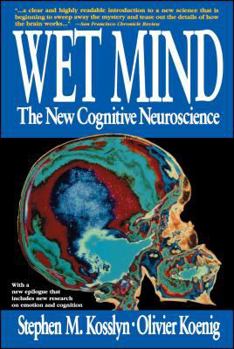Wet Mind: The New Cognitive Neuroscience
Select Format
Select Condition 
Book Overview
Drawing on recent research in neurobiology, artificial intelligence, cognitive science and medicine, this book provides a comprehensive overview of the functions and dysfunctions of the brain. It also... This description may be from another edition of this product.
Format:Paperback
Language:English
ISBN:0028740858
ISBN13:9780028740850
Release Date:January 1995
Publisher:Free Press
Length:624 Pages
Weight:1.80 lbs.
Dimensions:1.5" x 6.0" x 9.2"
Customer Reviews
1 rating
Computer Vision makes possible Language
Published by Thriftbooks.com User , 17 years ago
Five principles of Neural networks: 1. Division of labor. Because connections between input and outputs can interfere with each other, it is more efficient to have separate networks perform different mappings. 2. Weak modularity: Individual neural networks are not independent, discrete "module" within a larger system. One can analyze the black box of the neural network and figure out how it performed a particular task. The task is decided in advanced by someone who defines that task and completes the input/output mapping. Networks are great at generalizing but every task cannot be known. We learn about the implications of a theory by watching the way a model behaves. The extent the model can match the pattern of an organism response to stimuli the more serious we take the model. The logical exercise is to analyze which processing subsystem produces a specific behavior. 3. Functional relationship between subsystems. "We assume that a group of networks may work to compute complex input/output mappings, and so a processing subsystem may have an internal structure. In some case, the same subsystem may be a member of more than one processing subsystem." Some parts of the brain are like letters in a crossword puzzle, serving as components of more than one word and imply a break down in modularity. However, a network input/outputs works to compute one function. 4. Localization in the brain: Critical members of the network are localized to a specific area of the brain. However, not all neurons that sub serve a given computation needs to be in the same place. 5. Constraint Satification: The brain seems to use different sorts of information simultaneously and meet constraints, at the same time. Visual Perception: A visual stimulus based on the eye shifting brings the image into the attention window of the visual buffer. The attention window selects some region of the visual buffer for detailed processing. The pattern is sent to two subsystems: the ventral system and the dorsal system. The ventral system runs from the occipital lobe down to the inferior temporal lobe; the ventral system encodes information about key properties of shapes, colors, and textures. The dorsal system runs from the occipital lobe up to the parietal lobes; the dorsal system encode information about special relationships, guide movement, and special properities. The preprocessing subsystem extracts nonaccidental properties, such as, symmetrical edges, parallel lines, and point at the front and perceptual units, such as regions of the same color or blotches that have been proven distinctive in the past; hypothesis testing cycle is repeated until enough information has been encoded to implicate a particular object in associative memory. The outputs of the dorsal and ventral come together at the associative memory; associative memory pattern matches and gives meaning, a name, a category, and feeling about the object; the associative memory pattern match is a p




